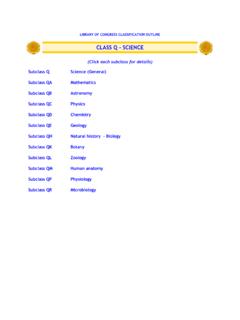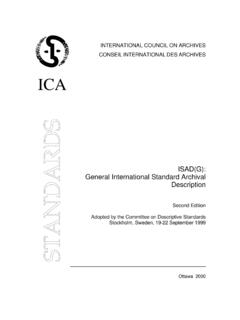Transcription of McQuail’s Mass Communication Theory
1 McQuail s MassCommunicationTheoryDedicated to the future media audiences, especially:Laurence, Alexander, William, Noah, Chaia, Alice, Miranda, Anarosa, and Ava, grand children s MassCommunicationTheory6th editionDenis McQuail Denis McQuail 1983, 1987, 1994, 2000, 2005, 2010 First edition published 1983 Second edition published 1987 Third edition published 1994 Fourth edition published 2000. Reprinted 2001, 2002, 2003, 2005 Fifth edition published 2005. Reprinted 2006, 2007, 2008, 2009 Apart from any fair dealing for the purposes of research or private study, or criticism or review, as permitted under the Copyright,Designs and Patents Act, 1988, this publication may be reproduced, stored or transmitted in any form, or by any means, only with theprior permission in writing of the publishers, or in the case of reprographic reproduction, in accordance with the terms of licences issuedby the Copyright Licensing Agency.
2 Enquiries concerning reproduction outside those terms should be sent to the Publications Ltd1 Oliver s Yard55 City RoadLondon EC1Y 1 SPSAGE Publications Teller RoadThousand Oaks, California 91320 SAGE Publications India Pvt LtdB 1/I 1 Mohan Cooperative Industrial AreaMathura RoadNew Delhi 110 044 SAGE Publications Asia-Pacific Pte Ltd33 Pekin Street #02-01 Far East SquareSingapore 048763 library of congress Control Number: 2009932171 British library Cataloguing in Publication dataA catalogue record for this book is available from the British LibraryISBN 978-1-84920-291-6 ISBN 978-1-84920-292-3 (pbk)Typeset by C&M Digitals (P) Ltd, Chennai, IndiaPrinted and bound in Great Britain by TJ International Ltd, Padstow, CornwallPrinted on paper from sustainable resourcesContents PrefaceHow to Use this BookPART 1 PRELIMINARIES 1 Introduction to the Book 2 The Rise of mass MediaPART 2 THEORIES 3 Concepts and Models for mass Communication 4 Theory of Media and Society 5 mass Communication and Culture 6 New Media New Theory ?
3 7 Normative Theory of Media and SocietyPART 3 STRUCTURES 8 Media Structure and Performance: Principles and Accountability 9 Media Economics and Governance10 Global mass CommunicationPART 4 ORGANIZATIONS11 The Media Organization: Pressures and Demands12 The Production of Media CulturePART 5 CONTENT13 Media Content: Issues, Concepts and Methods of Analysis14 Media Genres and TextsPART 6 AUDIENCES15 Audience Theory and Research Traditions16 Audience Formation and ExperiencePART 7 EFFECTS17 Processes and Models of Media Effects18 Social-Cultural Effects19 News, Public Opinion and Political CommunicationPART 8 EPILOGUE20 The Future of mass Communication GlossaryReferencesIndexPreface This version is an updating and consolidation of the last edition, building with more confidence on theproposition that mass Communication is evolving and becoming more complex rather than witheringaway.
4 The earlier expectation of demise was based on the belief that the new media of publiccommunication that were appearing in the latter part of the 20th century would ultimately prove to besuperior in all respects to the relatively crude forms of traditional mass media (especiallynewspaper and television broadcasting). This supposition was itself out of step with the lessons ofmedia history that has already demonstrated the power of different media forms to adapt and survivein new environments. It is now the turn of the traditional mass media to adapt to new technology underchanging social, economic and cultural conditions. The persistence of mass Communication as aprocess and the continued relevance of much of the accumulated Theory and research stem, even so,from continuity in the kind and direction of dominant social forces, especially those that fall under theheadings of globalization and modernization/development.
5 In the same way that media of all kinds areconverging, so also are theories of the new and old media the expectation that mass Communication will evolve and survive, the changes takingplace to, and within, the spectrum of public Communication media are fundamental, accelerating andopen for all to see. They outpace the capacity of a book of this kind to keep pace with what ishappening on the ground. But the purpose, as before, is not to chart media change, but to provide somerelatively firm theoretical islands or platforms from which to observe and understand what ishappening around us. The evidence for all this comes primarily from the continuing stream of findingsof academic research in media and Communication , which is itself always anchored in and directedby Theory , but also rather slow to appear.
6 The main changes made in this edition have been motivatedby the aims of testing the continued relevance of old Theory and of adding, where possible, to thestock of Theory . Often it is reports about the effects and significance of new media that are mostfruitful for the second process of revision of this kind depends not only on scanning and evaluating newly publishedtheory and new empirical evidence. It also calls for continuing contact with others engaged in moreactive ways with the field of inquiry. I have been fortunate in having continued opportunities forexchange of ideas and for learning new things from colleagues, friends and students. I cannot repay alldebts, but I would like to mention here some of the people, places and events that have been ofparticular help on the journey. I have been much helped, thanks to Karin Raeymackers, by readyaccess to the Communication library of the University of Ghent, with its now rare collection of currentand recent international journals.
7 I have also appreciated regular contact with my co-editors andothers associated with the European Journal of Communication , especially Els de Bens, PeterGolding and Liesbet van Zoonen. The periodic seminars organized by the EJC have been an importantlearning experience. A continuing link with the Euromedia Research Group, by participation inmeetings and publication, has been another source of stimulation (too many names to name). Anotherrecurring source of stimulation has been the chance to participate in the annual doctoral SummerSchool organized by the European Communication Research Association (ECREA) and held for thelast five years at the University of Tartu, Estonia. I have benefited also from invitations to teach orgive lectures at a number universities. Particular thanks are due in this respect to Prof.
8 TakesatoWatanabe at Doshisha University, Kyoto. I have similar debts to Helena Sousa, at the University ofMinho, Potugal; Josef Trappel at the University of Zurich, Elena Vartanova at Moscow UniversityFaculty of Journalism; Miquel de Moragas Sp at the Autonomous University of Barcelona; MiroljubRadoikovich, University of Belgrade; Konca Yumlu at Ege University, Izmir; Vita Zel e and IntaBrik e at the University of Latvia. Naming names is always a bit invidious and I have to omit many,but I will just mention my appreciation of renewed contact with my comrade-colleague of old, JayBlumler, and last but not least my association with the self styled Soul Brothers, Cliff Christians, TedGlasser, Bob White and Kaarle Nordenstreng, especially as our eternal book on normative mediatheory has at last appeared. It is more than mere convention to say that the present book would nothave appeared without the initiative, persistence and enthusiasm of Mila Steele, of Sage hope it lives up to her high hopes.
9 It is probably the last edition of this book, at my hand at least, butif mass Communication endures so also will mass Communication Preface was written during a visit from young grandchildren who are already forming thefuture audience for mass media. For this reason I have dedicated the book to them all, borrowing anidea from Hanno Hardt. My last words of thanks are to my wife, Rosemary, for making so , Hampshire, UK, November 2009 How to Use this Book The text can best be used by readers as a resource for learning about a particular topic. There areseveral ways this can be approached. The table of contents provide an initial orientation, or map, tothe book, and each chapter begins with a list of the main headings to help you orient yourself in thebook. The subject index at the end of the book includes all key words and topics and can also be usedfor an initial chapter contains boxes to help you explore the background, relevance and research on thethemes and theories discussed in the book.
10 Symbols beside the boxes help you navigate so you canquickly find summaries; review; name-check; and take it further with key quotes and additionalinformation. Theories: These boxes give a bullet-point outline to key theoreticalpropositions, helping consolidate your understanding of the essential themes : These boxes supplement the discussion with essential additioninformation. Tables and lists give you extra information to help ground theorywith empirical : Use these as an easy reference to summarize many key themes andprinciples as you go : Quotes from major thinkers and texts clarify and emphasizeimportant principles and will help familiarize you with the some of the researchliterature on mass Communication : Key questions reflect in summary form the main divisions and pointsof debate in major issues of : Research examples will help you understand some of the ways inwhich theoretical questions can be answered readings: An important aim of the book is to provide a guide to follow-up study.


